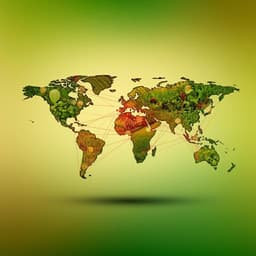
Environmental Studies and Forestry
Impacts of the global food system on terrestrial biodiversity from land use and climate change
E. H. Boakes, C. Dalin, et al.
Discover how Elizabeth H. Boakes, Carole Dalin, Adrienne Etard, and Tim Newbold investigate the biodiversity impacts of the global food system using advanced modeling techniques. Their research uncovers the significant role of greenhouse gas emissions and land use in biodiversity loss, revealing critical insights into the costs borne by nature. Dive into their findings that could reshape environmental decision-making!
~3 min • Beginner • English
Introduction
Anthropogenic pressures continue to drive biodiversity loss despite conservation efforts, with land use currently the greatest driver and climate change expected to increase considerably, potentially matching or surpassing land use by 2070. Agriculture for food covers an estimated 38–55% of Earth’s habitable land and the global food system is responsible for a large share of anthropogenic greenhouse gas (GHG) emissions. Food is increasingly traded internationally, displacing biodiversity impacts geographically along supply chains. Understanding and separating the contributions of agricultural land use and GHG emissions to biodiversity loss is essential to inform sustainable production, consumption, and trade policies. The authors aim to quantify the biodiversity impacts embedded in the global food system (2011) using consistent biodiversity metrics for land-driven and GHG-driven pathways, across 49 regions and 33 food-related products, comparing species richness and rarity-weighted richness to assess how metric choice influences conclusions and policy recommendations.
Literature Review
The paper reviews prior use of environmentally extended multi-regional input-output (EEMRIO) models to trace environmental impacts along supply chains, noting their advantages in avoiding double counting and handling complex interdependencies via the Leontief inverse. Previous biodiversity footprint studies include: (i) threat-based approaches using the IUCN Red List (Lenzen et al.), which assume uniform threat across species’ ranges and exclude non-threatened species; (ii) hotspot and bird-based loss metrics; (iii) cSAR-based approaches estimating species committed to extinction from land conversion and trade; and (iv) GLOBIO-based Mean Species Abundance (MSA) approaches combining land use and climate (Wilting et al.), which assumed uniform sensitivity across regions and used different biodiversity metrics for land and climate. Studies show that choice of biodiversity indicator (local vs regional metrics) can lead to different outcomes (Marquardt et al.). The authors identify gaps: lack of comparable biodiversity units for land and climate drivers, limited accounting for regional variation in sensitivity, and insufficient consideration of rarity-weighted richness.
Methodology
The study couples EXIOBASE 3 MRIO (version 3.8.1) with biodiversity characterization to quantify production- and consumption-based footprints for 33 food-related sectors across 49 regions in 2011. Footprints are computed for land area, and for biodiversity using two local metrics: species richness (SR) and rarity-weighted richness (RWR). Land-driven characterization: (1) Spatial layers for 49 trade regions, six aggregated biomes (tropical forest; temperate/boreal forest; tropical grassland; temperate/montane grassland; Mediterranean; drylands), and 15 EXIOBASE agricultural land-use classes (cropland from SPAM/EarthStat; pasture from EarthStat) were combined on an equal-area grid (10 km). (2) Global SR and RWR maps for terrestrial vertebrates were derived by stacking species’ extent-of-occurrence maps (IUCN, BirdLife, Meiri et al., Roll et al.), filtered by extant/probably extant and breeding-season presence, and clipped to known elevational limits. (3) Biodiversity sensitivity to land use was estimated using PREDICTS models (local SR: 21,986 locations; RWR: 15,198 locations), allowing land-use effects to vary by biome. (4) For each region-biome-land-use combination, the proportional change in SR or RWR relative to primary vegetation was applied to local baseline SR or RWR, averaged over agricultural areas, and multiplied by EXIOBASE’s area of land used per €1M of product to yield characterization factors (CFs) with units species × km² (SR) or range fractions × km² (RWR). GHG-driven characterization: (1) EXIOBASE emissions for CO₂, CH₄, and N₂O associated with production of each product-region were aggregated (combustion air, non-combustion, agriculture, waste). (2) Emissions were converted into a projected mean global temperature rise in 2031 from a 2011 emission pulse using the 20-year Global Temperature-change Potential (GTP) coefficients from IPCC AR5 (CO₂ 6.84×10⁻¹⁶ °C/kg; CH₄ 4.62×10⁻⁸ °C/kg; N₂O 1.89×10⁻¹⁵ °C/kg). (3) Spatially varying warming under RCP8.5 for 2011–2031 was represented via a weighting factor derived from the mean of four climate models (GFDL-ESM2M, HadGEM2-ES, IPSL-CM5A-LR, MIROC5). (4) A grid of biodiversity sensitivity to temperature (projected change in local SR per 1 °C) was used to estimate fractional loss in SR or RWR per grid cell, scaled by local warming, baseline SR/RWR, and cell area to produce GHG-driven CFs in the same units as land-driven CFs. EEMRIO footprinting: Using the environmentally extended Leontief model, the study calculates production- and consumption-based footprints for total food, aggregated product groups (animal, crops, fertilizer, fish, other food, waste), per-area (per km² production) and per-capita (consumption) footprints, and net imports/exports. Assumptions and scope: biodiversity change from land conversion is immediate (historic conversion of all agricultural land used in 2011); GHG-driven biodiversity change is tied to a single year’s emissions (2011) realized as temperature impacts by 2031; emissions from land conversion are excluded due to data constraints; forestry and infrastructure land uses are excluded; biodiversity models represent terrestrial vertebrates for climate impacts and vertebrates/invertebrates/plants/fungi for land-use impacts via PREDICTS; impacts of agricultural intensification practices are not modeled explicitly.
Key Findings
- Land area is an inadequate proxy for biodiversity impact: land-driven biodiversity footprints differ markedly from land-area footprints due to regional variation in species richness and biome-specific sensitivity to land use. Rarity-weighted richness (RWR) emphasizes higher biodiversity costs in Central and South America relative to species richness alone. - Regions with largest land-area footprints (e.g., RoW Africa, China, RoW Asia & Pacific) are not always those with the largest land-driven biodiversity footprints; Brazil and RoW Central & South America rank highly for land-driven SR and especially RWR footprints. - GHG-driven versus land-driven impacts diverge spatially. India and China have the highest GHG-driven biodiversity loss, followed by RoW Africa; Western Europe and North America drive relatively high GHG-driven loss in the ‘Other Food’ sector. - Ratios of land-driven to GHG-driven biodiversity loss vary widely by region and metric: from 16 (RWR production footprint in Russia) to 855 (RoW Central & South America), with several regions (China, India, RoW Asia & Pacific) around 50. In several regions, a single year of food-related emissions is associated with ≥2% of the total historic land-driven biodiversity loss, implying that a decade of similar emissions would add ~20% to historic land-use losses (and this excludes land-conversion emissions). - Methane dominates food-related GHG-driven biodiversity footprints: CH₄ accounts for ~70% of food’s GHG-driven biodiversity footprint (vs 42% across all EXIOBASE products), CO₂ ~18% (vs 54%), N₂O ~12% (vs 4%). Methane contributions are highest for animal products, paddy rice, and food waste; N₂O dominates fertilizer and fishing products’ GHG-driven impacts. - Food-related products accounted for ~23% of total EXIOBASE emissions in 2011. The total GHG-driven biodiversity footprint of food-related products is about 1% of the total land-driven richness footprint (for a single year of emissions vs historic land conversion). - Product patterns: animal-derived products generally have much higher biodiversity footprints than plant-derived, though Asia & Pacific shows high crop-related footprints (e.g., paddy rice, wheat). ‘Other Food’ (processed foods and beverages) often has high GHG-driven footprints. - Per-area production footprints: Taiwan, the Netherlands, and Belgium have among the highest per-area land-driven and GHG-driven production footprints; Brazil, India, Mexico are high both in totals and per-area. - Per-capita consumption footprints: Australia and Luxembourg have extremely high per-capita land-driven footprints; several regions (e.g., Belgium, Estonia, Luxembourg, Ireland) have high per-capita GHG-driven footprints driven by specific products (dairy, cattle, processed foods, food waste). - Trade patterns: Major net importers of embedded land- and GHG-driven biodiversity loss include the United States, United Kingdom, Germany, Russia, Japan, China, and RoW Middle East. Some regions are net importers for land-driven but exporters for GHG-driven impacts (e.g., India), or vice versa (e.g., Indonesia). - Imported share of footprints is high in many European regions: for example, imported shares include Netherlands ~70% and Luxembourg ~88% of land-driven SR footprint; for GHG-driven biodiversity, Netherlands ~70% and Luxembourg ~80%. - A higher percentage of plant-derived biodiversity footprints is traded between aggregated world regions than animal-derived footprints (e.g., for GHG-driven SR: plants ~11% vs animals ~7%).
Discussion
The study demonstrates that using biodiversity metrics that reflect regional species richness and biome-specific sensitivities fundamentally alters the assessment of embedded impacts relative to land area alone. Rarity-weighted richness highlights risks to narrow-ranged species, particularly in parts of Central and South America, informing conservation priorities that might otherwise be missed. Comparing land-driven and GHG-driven impacts in consistent units reveals that climate-related biodiversity losses from ongoing food-system emissions accumulate rapidly, with methane as the dominant near-term driver. This underscores the importance of complementing land-use strategies with aggressive mitigation of food-related GHGs—especially methane from livestock, rice systems, and waste—to prevent GHG-driven biodiversity impacts approaching historic land-use losses within decades. The findings inform policy on sustainable production, consumption, and trade, emphasizing demand-side shifts (reduced livestock consumption, plant-based diets), supply-side transitions (support for farmers to move away from livestock), and trade policies that avoid offshoring biodiversity losses to biodiverse tropical regions. They further underscore that metric choice (SR vs RWR) changes which regions and products are prioritized, arguing for multi-metric reporting to capture diverse biodiversity dimensions while maintaining interpretability for decision-makers.
Conclusion
The paper presents a consistent framework to quantify land-driven and GHG-driven biodiversity footprints of the global food system in the same units, incorporating regional and biome-specific sensitivity and accounting for local species richness and rarity. Key contributions include: (i) comparable biodiversity metrics for land use and climate drivers; (ii) explicit treatment of rarity-weighted richness to highlight risks to narrow-ranged species; (iii) disaggregation of GHG impacts by gas, revealing methane’s dominant role. The analysis shows that land area alone understates impacts in species-rich regions, while GHG-driven biodiversity loss from food—dominated by methane—can add substantially to future losses. The presented measures are straightforward to compute and can be integrated into environmental impact assessments and corporate/government decision-making, including supply chain management, dietary guidance, and trade policy design. Future work should incorporate land-conversion emissions, capture agricultural intensification (e.g., via HANPP) and ecosystem function degradation, expand taxonomic coverage for climate-impact metrics, update to more recent land-use data, and increase regional and sectoral resolution in MRIO frameworks.
Limitations
- MRIO-related: sectoral and regional aggregation (including ‘Rest of World’ regions and ‘Other Food’ sector) can bias embodied impact estimates; assumption of price homogeneity; reporting limitations; and use of 2011 data for land use likely underestimates current impacts. - Scope exclusions: forestry, infrastructure, and emissions from land conversion are excluded; biodiversity impacts of agricultural intensification practices and indirect ecosystem function losses are not modeled explicitly. - Biodiversity coverage: climate-impact biodiversity metrics are limited to terrestrial vertebrates due to data constraints; land-use impacts rely on PREDICTS which, while broad, still aggregates land-use classes and intensity. - Modeling choices: GTP with a 20-year horizon emphasizes near-term warming (appropriate for methane) but differs from 100-year integrated approaches, complicating direct comparison with some prior studies. - Data uncertainties: variability and uncertainty in pasture mapping, cropland distributions, and MRIO inventories can influence product- and region-level footprints; regional aggregation in MRIOs can under/overestimate land-use impacts relative to fully disaggregated models.
Related Publications
Explore these studies to deepen your understanding of the subject.







